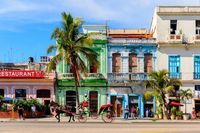Cuba has successfully reconnected its national electrical grid after suffering through nearly two days of widespread power outages. By the evening of March 16, 2025, energy officials reported power was restored to the majority of Havana, the capital city, following the significant blackout affecting up to 10 million people across the island.
The crisis began on the evening of March 14, when around 8:15 p.m. (00:15 GMT), the national power grid collapsed due to a breakdown at the Diezmero substation located in Havana. This initial failure sparked a catastrophic chain reaction, halting power generation entirely across Cuba, which has faced numerous challenges with its aging energy infrastructure.
By Sunday evening, Havana's electric company indicated two-thirds of its clients—approximately 66%—had their electricity restored. Officials expressed optimism, stating they expected the number to continue climbing overnight. Cheers erupted throughout neighborhoods as lights flickered back on, marking the end of what had been two long days of darkness.
While the restoration was underway, many residents had endured severe disruptions. Businesses, including restaurants and shops, were forced to close, and streetlights nationwide were inactive, creating dangerous conditions. The power outages blanketed regions across the densely populated capital city and other provinces, including Pinar del Río, which was the last area to receive electricity just before nightfall on March 16.
Officials reported the country's two largest oil-fired power plants, Felton and Antonio Guiteras, were operational again, which was seen as integral to easing the nationwide crisis. Even with the gradual restoration of power, officials noted they were still only able to generate about one-third of the typical daily demand for electricity, leaving many areas without adequate power yet.
This incident marks Cuba's fourth nation-wide blackout since October 2024. Even prior to this latest major outage, residents had been enduring frequent blackouts, sometimes lasting as long as 20 hours daily due to the country's strained energy resources.
Cuba's energy crisis has been exacerbated over recent years by international sanctions, predominantly from the United States. The Cuban government has placed blame for the current crisis squarely on the Cold War-era trade embargo and increased restrictions implemented during President Donald Trump's administration. The island nation is now pushing to establish large solar farms, receiving assistance from China, as part of its strategy to diminish reliance on outdated oil-fired power generation.
"Cuba blames the country's mounting energy crisis on a Cold War-era US trade embargo and fresh restrictions from US President Donald Trump," officials state, reflecting the government's frustrations concerning external pressures impacting its energy infrastructure.
With schools closed from March 16 to March 18 throughout several provinces, including Pinar del Río, Artemisa, and Mayabeque, authorities are taking precautions to assure safe conditions for students returning to the classrooms.
The aftermath of the blackout and the subsequent restoration of power highlight the challenges and vulnerabilities inherent within Cuba’s energy sector. Residents, who found themselves enduring intermittent power for years even before this crisis, are understandably apprehensive about the stability of their electricity supply moving forward. Many are asking: will the current restoration efforts be sufficient to prevent future outages?
The government's initiatives to advance solar energy may offer hope amid these difficulties, as Cuba aims to establish more sustainable energy solutions. The larger question remains—how effectively can the government combat the long-standing effects of the embargo and manage to create energy independence for the Caribbean nation? This dilemma will be pivotal for Cuba’s future as it confronts inherent vulnerabilities in its energy policy and infrastructure.

